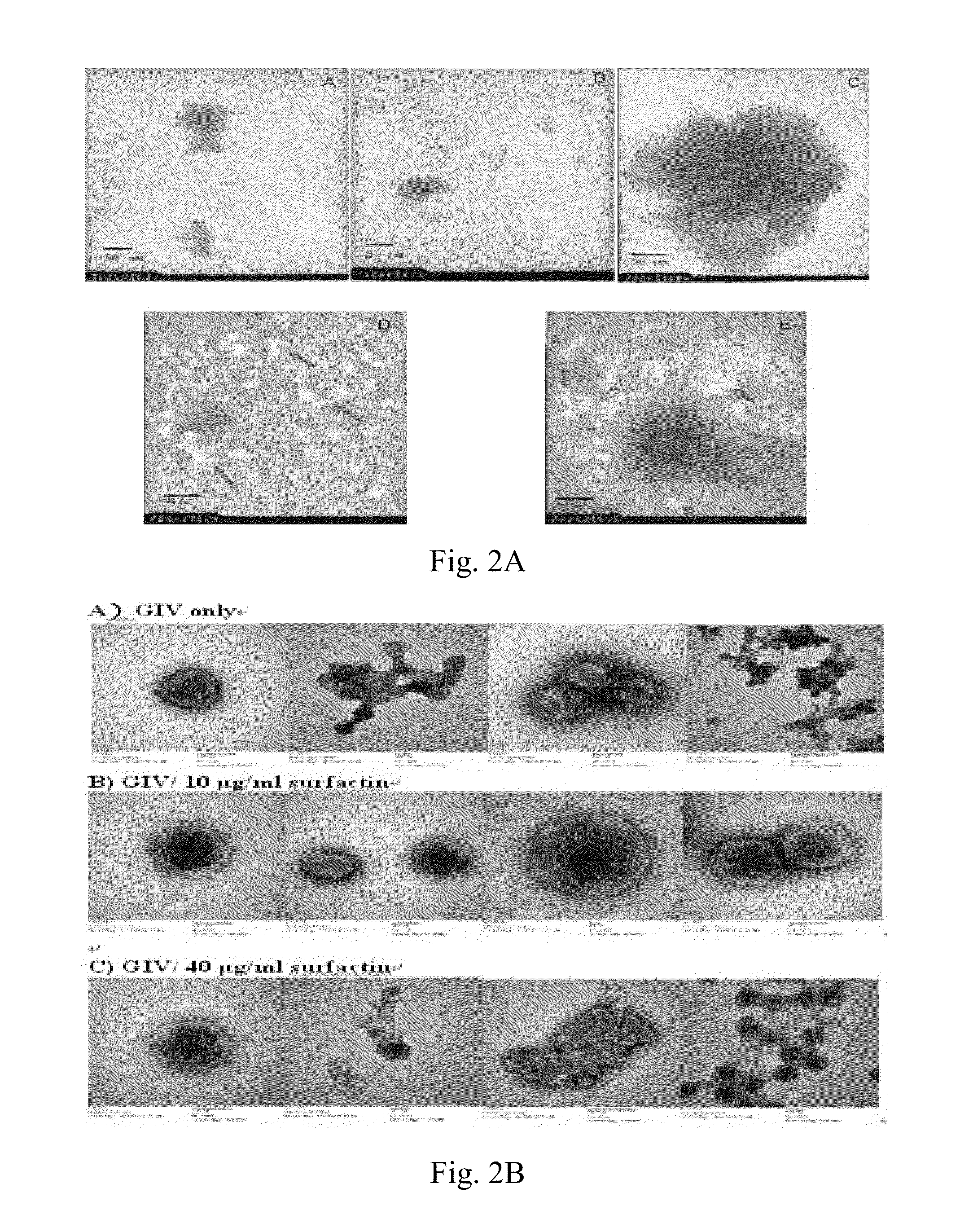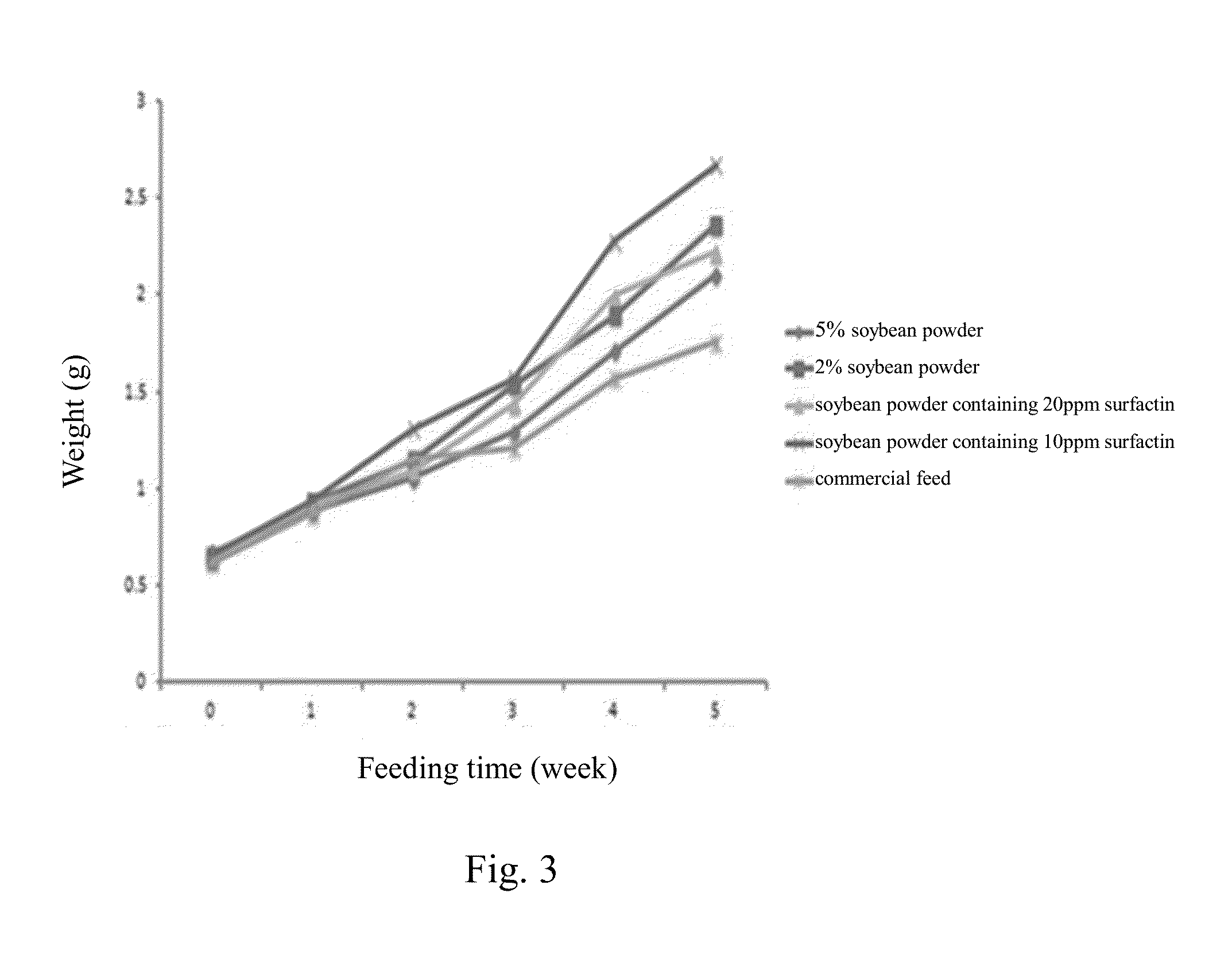Method for producing feed additive containing surfactin
a technology of surfactin and feed additive, which is applied in the field of aquaculture technology and biotechnology, can solve the problems of destroying the cell membrane of bacteria, producing drug resistance, and death of mycoplasma, and achieves the effects of reducing the harm of antibiotics to animals, reducing the harm of antibiotics, and destroying the intestinal microbial balan
- Summary
- Abstract
- Description
- Claims
- Application Information
AI Technical Summary
Benefits of technology
Problems solved by technology
Method used
Image
Examples
example 1
Preparation of the Food Additive Containing Surfactin by Semi-Solid State Fermentation
[0033]This patent utilizes high-yield mutant strain of Bacillus subtilis (BCRC No. CGMCC 10270) for semi-solid state fermentation by using soybeans as the substrates. The surface of the fermented soybeans is rich in secondary metabolite-surfactin. The substrate of fermentation can be other cheaper substrates such as rape seed meal, palm oil cake, coconut oil cake, poonac, agricultural by-products or waste and trash (potato peel, cassava peel and apple peel).
[0034]The bacterial culture of high-yield mutant strain of Bacillus subtilis was inoculated to the mixture of 30% mineral salt medium and 10% soybeans and subjected to semi-solid state fermentation for 48 hours under the condition of 30° C., 80% humidity, followed by drying the fermented soybeans at 55° C. for 2-3 hours. After grinding, the soybeans were sieved by a 60-mesh sieve and stored at 4° C., wherein each kilogram of the soybean powder c...
example 2
Antimicrobial Testing for Surfactin
[0035]To examine whether surfactin has antimicrobial activity, in vitro susceptibility test was conducted.
[0036]Preparation of bacterial culture of Escherichia coli DH5α, Vibrio harveyi, Vibrio alginolyticus, Vibrio anguillarum, Vibrio salmonicida, Aeromonas hydrophila and Staphylococcus epidermidis by inoculation of these bacteria onto LBA (E. coli·DH5α) or TSA (+1.5% NaCl) and incubation at 37° C. for 16 hours. Later, the colonies were scraped off and dissolved in specific medium; the concentration was adjusted to OD540 of 1 (1×109 colonies / c.c. culture medium), 100 μl of bacterial culture were add to 900 μl of LB or TSB (+1.5% NaCl) to give a concentration of 5×105 CFU / ml.
[0037]Preparation of Fungal Cultures
[0038]Aspergillus niger was inoculated onto the MEAIII plate and incubated at 25° C. for 48 hours, the colonies were scraped off into specific culture medium. Bacterial culture was spread onto the MEAIII plate after serial dilution and the nu...
example 3
Neutralization Test of Surfactin and Nervous Necrosis Virus (NNV)
[0042]To examine whether surfactin has anti-viral activity, neutralization test was conducted. One day before the test, GF-1 cells were seeded onto a 96-well microplate at the density of 5×103 cells per well and cultured overnight (16 hours) until 80% confluency before subjected to titration. First, a 10-fold serial dilution, from 101 to 1010, of the test viral culture was performed and then the diluted viral culture was inoculated onto a 96-well plate, 100 μl per well. Shake the plate to mix the viral culture, a total of 8 repeats and incubate the plate at 28° C. for 90 minutes to allow virus adsorption. The old culture medium was replaced with 200 μl of 1% FBS-L15 culture medium and the plate was incubated the 28° C. for additional 9 days. The 50% tissue culture infection dose (TCID50) was calculated based on the Reed-Muench Method and is represented by TCID50 for neutralization index (NI=original virus titer / NI tite...
PUM
| Property | Measurement | Unit |
|---|---|---|
| humidity | aaaaa | aaaaa |
| temperature | aaaaa | aaaaa |
| surface tension | aaaaa | aaaaa |
Abstract
Description
Claims
Application Information
 Login to View More
Login to View More - R&D
- Intellectual Property
- Life Sciences
- Materials
- Tech Scout
- Unparalleled Data Quality
- Higher Quality Content
- 60% Fewer Hallucinations
Browse by: Latest US Patents, China's latest patents, Technical Efficacy Thesaurus, Application Domain, Technology Topic, Popular Technical Reports.
© 2025 PatSnap. All rights reserved.Legal|Privacy policy|Modern Slavery Act Transparency Statement|Sitemap|About US| Contact US: help@patsnap.com



